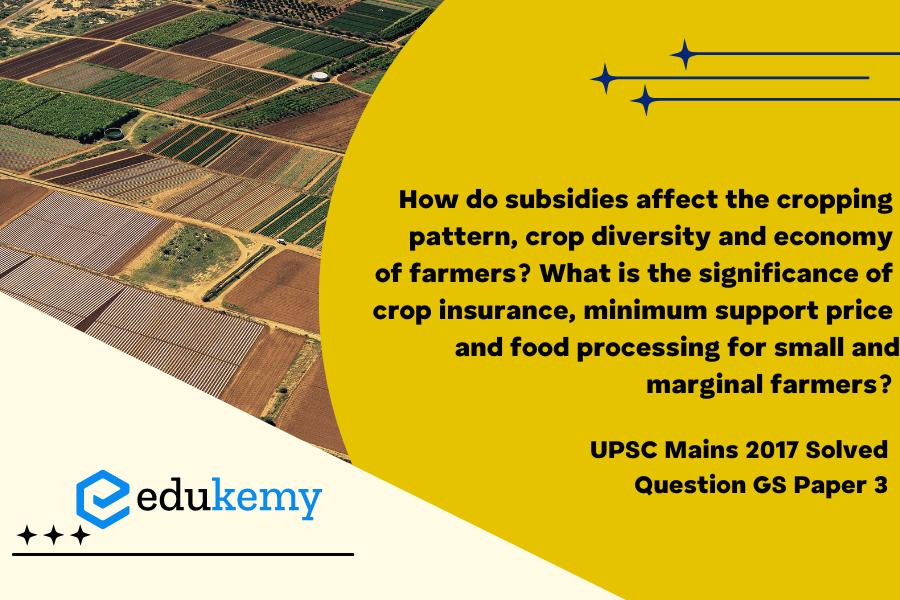Subsidies play a pivotal role in shaping the cropping pattern, crop diversity, and overall economic landscape for farmers. These financial incentives provided by the government can significantly impact the choices farmers make regarding the crops they cultivate. Subsidies, often targeted towards specific crops or inputs, influence farmers’ decisions by making certain crops more financially viable, leading to shifts in cropping patterns. While subsidies can contribute to increased production of particular crops, they may also inadvertently discourage diversification as farmers may opt for crops that receive more substantial support, potentially compromising overall crop diversity.
In the context of small and marginal farmers, the significance of crop insurance cannot be overstated. Crop insurance acts as a crucial risk mitigation tool, providing a safety net for farmers in the face of unforeseen events such as natural disasters or crop failure. Similarly, the minimum support price (MSP) ensures that farmers receive a fair and remunerative price for their produce, shielding them from market fluctuations. For small and marginal farmers who often lack bargaining power, the MSP serves as a crucial mechanism for economic stability and livelihood sustenance.
Tag: Major crops, cropping patterns in various parts of the country. Issues related to direct and indirect farm subsidies and minimum support prices.
Contents
Decoding the Question:
- In Intro, try to write about agricultural subsidies.
- In Body,
- Discuss impact of subsidies on cropping pattern, crop diversity and economy of farmers.
- Discuss the significance of crop insurance, minimum support price and food processing for small and marginal farmers.
- Try to conclude by giving suggestions for farmers.
Answer:
Agricultural subsidies are the support in cash or kind to the farmers from the government. They are intended to help farmers by reducing input costs and increasing production. Currently, the government provides various subsidies to farmers like seeds and fertilizers, cheap input credit, subsidized electricity, irrigation, etc.

Impact of Agriculture subsidies:
- Cropping pattern: Crop selection gets distorted in favour of those crops which have high share of subsidies or attract large volume of subsidies. For example cheap electricity and irrigation subsidies motivated Punjab farmers to go for water guzzling crops like rice.
- Crop diversity: Crop diversity gives way to the standard staple crops where there is assured market and cost of production is low due to subsidies. For example wheat and rice are the standard crops in present times for Rabi and Kharif season respectively.
- Economy of farmers: Various subsidies ensure income support to farmers and safe stock of food grains. But at the same time it leads to distorted production patterns, resulting in food inflation.
Significance of various factors on small and marginal farmers:
- Crop Insurance: Crop insurance is very essential especially in the time of adverse seasonal and climatic changes. It provides income security in case of failure of crops for natural and other reasons. It also acts as a shock absorbent or safety cushion for their investment in agriculture activities. Crop insurance schemes in India are:
- Pradhan Mantri Fasal Bima Yojana (PMFBY)
- Weather based Crop Insurance Scheme (WBCIS)
- Coconut Palm insurance scheme (CPIS)
- Minimum Support Price: Minimum support price (MSP) ensures minimum guaranteed income for crops and protects farmers from market fluctuations and also helps farmers from middlemen exploitation. MSP has been successful in giving financial security for farmers which every year encourages farmers to get good prices for their produce.
- Food Processing Industry: It is a sunrise sector but has a very promising future in India. This sector is very important from the point of view of increasing shelf life of food and better income opportunity for small and marginal farmers. For a country like India where wastage is very high and over 80% of small and marginal farmers are with limited capacities, their income and standard of life can be enhanced through the food processing industry.
About 85 percent of India’s farmers operate less than five acres of land, half of which in many parts of India may be dry / rain-fed and only a part of their income comes from farming activity now with others coming from wages, off-farm and non-farm activities. So, any material improvement in the overall agricultural sector requires them to be in the growth drive. Therefore, the need is a strong political will, better policy and its implementation.
In case you still have your doubts, contact us on 9811333901.
For UPSC Prelims Resources, Click here
For Daily Updates and Study Material:
Join our Telegram Channel – Edukemy for IAS
- 1. Learn through Videos – here
- 2. Be Exam Ready by Practicing Daily MCQs – here
- 3. Daily Newsletter – Get all your Current Affairs Covered – here
- 4. Mains Answer Writing Practice – here


